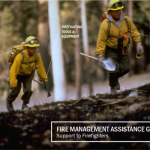FEMA and the state of Texas are highlighting Texas communities that have taken steps to reduce or eliminate long-term risk to people and property.
POTTER COUNTY, Texas – A multi-county initiative that began five years ago in the Texas panhandle provides residents an effective emergency alert system that helped save lives and property during the historic May 2015 floods.
The system, which has grown to include 150 counties, got its start in 2010 at the Panhandle Regional Planning Commission (PRPC). Funding was provided through FEMA’s Hazard Mitigation Grant Program.
“We found that only two of our 26 counties had any kind of mass notification capability,” said John Kiehl, regional services director of the PRPC. Established in 1969, the PRPC assists local governments in planning, developing and implementing programs designed to improve the general health, safety and welfare of the citizens in the Texas Panhandle.
“We discovered the other counties could not afford the cost of getting an alert system, much less maintain one,” said Kiehl, “but with help from FEMA and other partners, we were able to establish a reverse calling system to serve a wide array of emergency management purposes at a highly affordable cost.”
After considering different options, the PRPC decided to work with other jurisdictions that shared the need for mass notification. The result was the creation of the Alliance for Community Solutions (ACS), a group of stakeholders with a common interest in developing and implementing cost-effective, technology-based emergency management tools that benefit the group.
The PRPC applied for a grant from FEMA’s Hazard Mitigation Grant Program (HMGP) to fund the project so that all counties in the region could affordably obtain and maintain notification capabilities.
“We submitted a proposal for a system that would serve the entire 26,000-square-mile region,” said Kiehl.
The PRPC received about $785,000 from FEMA toward the project cost of more than $1 million. Most of the balance came from donations from individuals and private foundations. HMGP funds were used to purchase licenses at a cost of $600 per license. Each jurisdiction contributed $200 toward the cost of its license.
“Initially, we had difficulty sending short message system (SMS) text messages. We’d send out the first 25 calls, which would go through without a problem,” said Kiehl. “But after that, they started bottlenecking and bouncing back. We went through a period of time where people were getting their severe weather alerts a day and a half after the storm had passed.”
The issue was resolved by installing a new smartphone application called Fully Connect. Because it bypasses cell phone service provider servers, Fully Connect lets local officials send messages more quickly and reliably.
Kiehl said the system has been improved beyond its original design with enhancements funded by the PRPC and other ACS members. In addition to the common suite of tools that can send alerts by text, voice and email, the PRPC has included an English-Spanish translation. Other ACS partners have added more language modules including French, Mandarin, Cantonese, Vietnamese and German to better serve their non-English speaking residents.
The PRPC is now working on the last major FEMA-funded improvement: integrating the PRPC system with the federal Integrated Public Alert Warning System (IPAWS). When that happens, there will be seven different ways for emergency managers and authorized users to send alerts and notices to residents when their safety is at risk.
In May 2015, historic storms swept through central and south Texas over Memorial Day weekend, dumping up to 10 inches of rain over parts of previously drought-stricken Texas.
Medina County, an ACS partner more than 500 miles from the Panhandle, had funded a system enhancement that connected the county’s flood gauges to the mass notification system. As the river rose, automated notices were sent to keep county responders and residents aware of the situation. The PRPC is now looking to take advantage of this enhancement in the Panhandle.
What the PRPC did in the region is now serving 150 other counties in Texas because they are all working with the same provider. Every enhancement put into the system by any one of the counties is available to all other counties and jurisdictions within those counties, at no additional cost.
“FEMA has invested a lot of money in this initiative and we wanted the return to be as great as possible,” said Kiehl. “One of the best outcomes of this project is the partnership that’s been forged through ACS.
“Together, we’ll continue to cost-effectively improve this system long after our HMGP project has been closed out,” Kiehl said. “And anytime an ACS partner adds a system enhancement, all ACS members will benefit from it.”
For additional information about the Texas Panhandle Partnership Regional Alert System, visit: Panhandle Regional Planning Commission.
To learn more about how cities and towns across Texas are building stronger, safer communities, visit Best Practice Stories | FEMA.gov.
###
FEMA’s mission is to support our citizens and first responders to ensure that as a nation we work together to build, sustain, and improve our capability to prepare for, protect against, respond to, recover from and mitigate all hazards.







